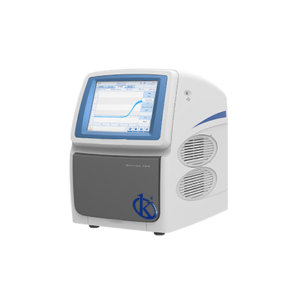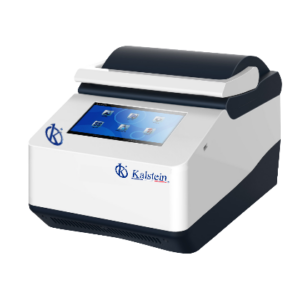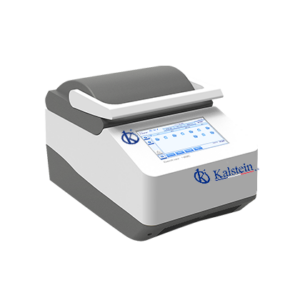Description
The Automatic Nucleic Acid Extractor YR01869-2 is a state-of-the-art tool engineered to enhance the nucleic acid extraction process with exceptional efficiency. Leveraging rotary mixing technology (RMT), this device accommodates up to 16 simultaneous yields, enabling the extraction of various samples without cross-interference. Its compact and adaptable design is perfect for labs requiring versatility across numerous assays. The innovative interface, awarded the Red Dot Design Award 2021, features a 6.86-inch touchscreen and remote control via smartphone or tablet apps, ensuring a seamless user experience.
Market Price
The price range for advanced lab equipment like the Automatic Nucleic Acid Extractor YR01869-2 generally spans from $8350 to $9160 USD, reflecting its status as a crucial investment for scientific and research laboratories. To receive a personalized quote and benefit from exclusive discounts, prospective buyers are encouraged to use the Kalstein Plus platform. This service promises not only tailored offers but also additional perks like specialized technical support.
Frequently Asked Questions
- What types of samples can I process with the Automatic Nucleic Acid Extractor YR01869-2? This versatile device is ideal for a vast range of samples, especially those requiring delicate nucleic acid extraction for DNA and RNA analyses.
- Is this device user-friendly? Absolutely, the user-centric design includes a 6.86-inch touchscreen and a remote control system easily accessible via smartphones or tablets, enhancing operational convenience and efficiency.
- How should I maintain the equipment? Ensure regular and thorough cleaning after each use and keep the software updated to guarantee optimal performance and longevity.
Advantages and Disadvantages
Advantages:
- High Flexibility: Manage multiple projects simultaneously with 16 x n different yields.
- Automated Workflow: Automatically identifies reagents and updates remotely, enhancing efficiency and minimizing manual labor.
- Advanced Protection System: Incorporates UV lamps and HEPA filtration to reduce contamination risks.
- Compact Design: The mobile design allows for experiments anywhere, adapting to various applications.
Disadvantages:
- High Price: Although it offers excellent value, the cost may be prohibitive for smaller labs with limited financial resources.
- Requires Specialized Maintenance: Advanced maintenance requires trained personnel to ensure proper functioning.
Product Use in the Field
The Automatic Nucleic Acid Extractor YR01869-2 is crucial in genetic research labs, clinical diagnostics, and biotechnology sectors. Its application in hospitals, forensic labs, or scientific research facilities spans nucleic acid extractions, biological sample analysis, and PCR projects. The device’s versatility and portability make it indispensable in environments needing rapid, reliable results.
Recommendations
To maximize the Automatic Nucleic Acid Extractor YR01869-2‘s capabilities, adhere to manufacturer maintenance guidelines and ensure consistent device cleaning and reagent protocol updating. Utilize its potential by conducting parallel assays to boost lab productivity. The UV and HEPA filtration systems should be employed to prevent cross-contamination and uphold result accuracy.
Features
- Model: YR01869-2
- Throughput: 16
- Processing Volume: 20-1700μL
- Sample Processing Volume: 200-500μL
- Compatible Consumables: Customized 96-deep-well plates, single 6-strip tubes
- Inter-well Difference: CV≤3%
- Mixing Method: Rotary mixing
- Rotary Speed: 100~3000rpm
- Temperature Control Range: 30°C to 120°C
- Temperature Control Accuracy: ±1.0°C
- Languages Supported: Chinese/English
- Operation Modes: Android systems in smartphones/tablets and 6.86 inch full-color LCD screen
- Disinfection: Ozone + UV disinfection
- Connection Port Type: USB port
- Weight: 7.4Kg
- Dimensions: 210mm(L)*229mm(W)*242mm(H)
- Power Supply: AC220V, 50Hz
Technical Specifications
| Model | YR01869-2 |
| Throughput | 16 |
| Processing Volume | 20-1700μL |
| Sample Processing Volume | 200-500μL |
| Compatible Consumables | Customized 96-deep-well plates, single 6-strip tubes |
| Inter-well Difference | CV≤3% |
| Mixing Method | Rotary mixing |
| Rotary Speed | 100~3000rpm |
| Temperature Control Range | Temperature control separately for lysis and elution. |
| Temperature range from 30°C to 120°C. | |
| Temperature Control Accuracy | Heating speed: 4.0±0.2°C/s. |
| Temperature accuracy: ±1.0°C. | |
| Temperature uniformity:≤1.0°C. | |
| Languages | Chinese/English |
| Protocol Management | Flexible to create, edit and delete protocols |
| Operation Mode | Mode 1: Android systems in smartphones/tablets |
| Mode 2: 6.86 inch full-color LCD screen | |
| Automatic Control | Automatic opening and closing of the experiment cabin |
| Reagent Identification | Automatic identification of reagent information and running the assays |
| Mixing Sleeve Monitoring | Real-time monitoring of the mixing sleeves status in experiment |
| Magnetic Bead Residue | ≤1% |
| Power Failure Protection | Choose freely whether or not to continue the experiment when the power is on again after cutting off |
| Disinfection | Ozone + UV disinfection |
| Auto Power-off | Auto power-off after UV disinfection |
| Negative-Pressure Filtration | Negative pressure HEPA filtration module |
| Connection Port Type | USB port |
| Weight | 7.4Kg (net) |
| Instrument Dimensions | 210mm(L)*229mm(W)*242mm(H) |
| Power Supply | AC220V, 50Hz |






